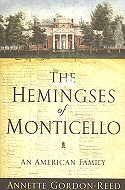|
The Hemingses of Monticello
|
|
Annette Gordon-Reed
|

|

In the mid-1700s the English captain of a trading ship that made runs between England and the Virginia colony fathered a child by an enslaved woman living near Williamsburg. The woman, whose name is unknown and who is believed to have been born in Africa, was owned by the Eppeses, a prominent Virginia family. The captain, whose surname was Hemings, and the woman had a daughter. She was named Elizabeth.
So begins The Hemingses of Monticello, Annette Gordon-Reed's riveting history" of the Hemings family, whose story come to vivid life in this brilliant researched and deeply moving work. Gordon-Reed, author of the highly acclaimed historiography Thomas Jefferson and Sally Hemings: An American Controversy, unearths startling new information about the Hemingses, Jefferson, and his white family. Although the book presents the most detailed and richly drawn portrait ever written of Sarah Hemings, better known by her nickname Sally, who bore seven children by Jefferson over the course of their thirty-eight-year liaison, The Hemingses of Monticello tells more than the story of her life with Jefferson and their children. The Hemingses as a whole take their rightful place in the narrative of the family's extraordinary engagement with one of history's most important figures.
Not only do we meet Elizabeth Hemings - the family matriarch and mother to twelve children, six by John Weyles, a poor English immigrant who rose to great wealth in the Virginia colony - but we follow the Hemings family as they become the property of Jefferson through his marriage to Martha Wayles. The Hemings-Wayles children, siblings to Martha, played pivotal roles in the life at Jefferson's estate.
We follow the Hemingses to Paris, where James Hemings trained as a chef in one of the most prestigious kitchens in France and where Sally arrived as a fourteen-years-old chaperone for Jefferson's daughter Polly; to Philadelphia, where James Hemings acted as the major domo to the newly appointed secretary of state; to Charlottesville, where Mary Hemings lived with her partner, a prosperous white merchant who left her and their children a home and property; to Richmond, where Robert Hemings engineered a plan for his freedom; and finally to Monticello, that iconic home on the mountain, from where most of Jefferson's slaves, many of the Hemings family members, were sold at auction six months after his death in 1876 .[…]
|
|
